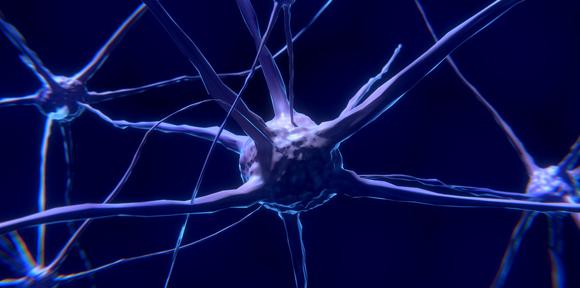Clik here to view.

Writing in Cell, the researchers from the University of Cambridge and University of Toronto also identify potential therapeutic targets for these currently incurable diseases.
ALS is a progressive and terminal disease that damages the function of nerves and muscle, affecting up to 5,000 adults in the UK at any one time. Frontotemporal dementia is a form of dementia that causes changes in personality and behaviour, and language difficulties.
A common characteristic of ALS and frontotemporal dementia is the build-up of clumps of misfolded RNA-binding proteins, including a protein called FUS, in the brain and spinal cord. This leads to the death of neurons, which stops them from communicating with each other and from reaching the muscles.
FUS proteins can change back and forth from small liquid droplets (resembling oil droplets in water) to small gels (like jelly) inside nerve cells. As the FUS protein condenses (from droplets to gel) it captures RNA and transfers it to remote parts of the neuron that are involved in making connections (known as synapses) with other neurons. Here, the protein ‘melts’ and releases the RNA. The RNA are then used to create new proteins in the synapses, which are essential for keeping the synapses working properly, especially during memory formation and learning.
In frontotemporal dementia and ALS, the proteins become permanently stuck as abnormally dense gels, trapping the RNA and making it unavailable for use. This damages nerve cells by blocking their ability to make the proteins needed for synaptic function and leads to the death of neurons in the brain and spinal cord.
In research funded by Wellcome, scientists used human cells that resembled neurons and neurons from frogs to investigate how the change in FUS from liquid droplets to small gels process is regulated and what makes it go awry. They found that this reversible process was tightly controlled by enzymes which chemically alter FUS making it able or unable to form droplets and gels. In frontotemporal dementia, the abnormal gelling was found to be caused by defects in the chemical modification of FUS. In motor neuron disease, it was caused by mutations in the FUS protein itself which meant it was no longer able to change form.
This research provides new ideas and tools to find ways to prevent or reverse the abnormal gelling of FUS as a treatment for these devastating diseases. Potential therapeutic targets identified by the researchers are the enzymes that regulate the chemical modification of FUS and the molecular chaperones that facilitate FUS proteins to change its form. These treatments would need to allow FUS to continue moving between safe reversible states (liquid droplets and reversible gels) but prevent FUS from dropping into the dense, irreversible gel states that cause disease.
Professor Peter St George-Hyslop from the Cambridge Institute for Medical Research said: “This was a very exciting set of experiments where we were able to apply cutting edge tools from physics, chemistry and neurobiology to understand how the FUS protein normally works in nerve cells, and how it goes wrong in motor neurone disease and dementia. It now opens up a new avenue of work to use this knowledge to identify ways to prevent the abnormal gelling of FUS in motor neurone disease and dementia.”
Dr Giovanna Lalli, from Wellcome’s Neuroscience and Mental Health team, said: “Motor neurone disease and frontotemporal dementia are devastating diseases that affect thousands of people across the UK, resulting in severe damage to the brain and spinal cord. By bringing together an interdisciplinary team of researchers, this study provides important new insights into a fundamental process underlying neurodegeneration. Through their research, the team have uncovered promising new ways to tackle these diseases.”
Reference
Qamar, S et al. FUS Phase Separation Is Modulated by a Molecular Chaperone and Methylation of Arginine Cation-π Interactions. Cell; 19 Apr 2018; DOI: 10.1016/j.cell.2018.03.056
Adapted from a press release by Wellcome
Scientists have identified the molecular mechanism that leads to the death of neurons in amyotrophic lateral sclerosis (also known as ALS or motor neurone disease) and a common form of frontotemporal dementia.
Image may be NSFW.
Clik here to view.
The text in this work is licensed under a Creative Commons Attribution 4.0 International License. For image use please see separate credits above.